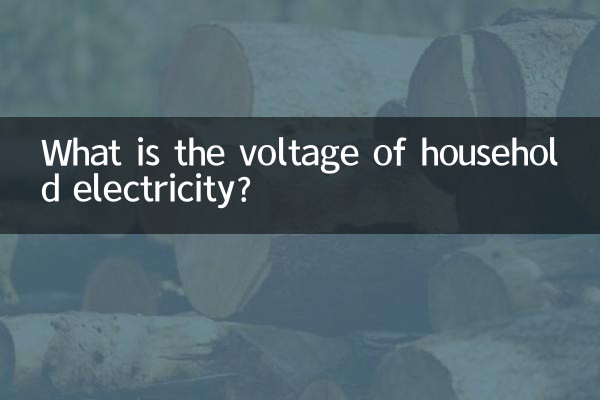What is the voltage of household electricity? This is a problem that many people encounter when renovating, purchasing electrical appliances, or performing home circuit modifications. With the development of science and technology and the improvement of living standards, it is particularly important to understand the basic knowledge of household electrical voltage. This article will combine hot topics and hot content in the past 10 days to provide you with detailed information about household electrical voltage, supplemented by structured data to help you better understand and apply it.
1. Basic concepts of household electrical voltage
Household electricity voltage refers to the standard voltage value of household electricity, which is usually used to power household appliances and lighting equipment. The household electrical voltage standards of different countries and regions are different. The following are the household electrical voltage standards of some common countries and regions:

| Country/Region | Voltage standard (V) | Frequency(Hz) |
|---|---|---|
| China | 220 | 50 |
| USA | 120 | 60 |
| Japan | 100 | 50/60 |
| Europe | 230 | 50 |
| Australia | 230 | 50 |
As can be seen from the table, China's household electricity voltage standard is 220V and the frequency is 50Hz. This is uniformly stipulated by the State Grid and applies to most household electricity consumption scenarios.
2. Frequently Asked Questions about Household Electricity Voltage
Among the hot topics in the past 10 days, discussions about household electricity voltage mainly focus on the following aspects:
1.Effects of voltage instability: Many users reported that the voltage at home was unstable, causing electrical appliances to be damaged or not work properly. Too high or too low voltage will cause damage to electrical appliances, especially precision appliances such as computers and refrigerators.
2.Appliance compatibility issues: With the popularity of overseas shopping and cross-border shopping, many users have purchased foreign electrical appliances, but due to different voltage standards, additional transformers or converters are required for use.
3.Home circuit modification: Circuit renovation in some old residential areas has become a hot topic, and users are concerned about how to upgrade voltage or optimize circuits without affecting daily life.
3. How to deal with household electrical voltage problems
In response to the above problems, here are some practical solutions:
| Question type | solution |
|---|---|
| Voltage is unstable | Install a voltage regulator or UPS power supply and check the circuit regularly |
| Appliance compatibility | Use a voltage converter and confirm the voltage range of the appliance before purchasing |
| Circuit modification | Hire professional electricians and use materials that meet national standards |
4. Future development trends of household electrical voltage
With the popularity of smart homes and green energy, the management and optimization of household electricity voltage have also become a hot topic. In the future, household electricity consumption may develop in the following directions:
1.Intelligent voltage management: Through smart meters and home energy management systems, monitor and adjust voltage in real time to improve electricity efficiency.
2.Distributed energy resources: The access to distributed energy sources such as solar energy and wind energy may place higher requirements on household voltage stability.
3.international standards: With the acceleration of globalization, household electrical voltage standards may gradually converge, reducing electrical compatibility issues.
5. Summary
Household electricity voltage is the basis for household electricity. Understanding its standards and common problems can help better ensure household electricity safety. Through the structured data and hot spot analysis in this article, I believe you will have a clearer understanding of household electrical voltage. If you have any questions or suggestions, please leave a message in the comment area for discussion.

check the details

check the details